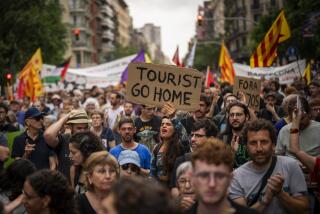Frozen Canals, Lakes Become Impromptu Rinks : Dutch Take Winter in Stride and Glide Along on Ice
- Share via
AMSTERDAM — Harsh winter weather has left much of Europe shivering indoors, but the Dutch take it in stride--on skates.
One glimpse of ice on the nation’s renowned waterways is enough to entice hordes of skaters to canals, rivers and remote lakes.
Teens speed around in the latest gear, young children take their first tottering steps holding onto an old chair and elderly couples make elegant figures on the ice.
From early morning until late at night, skaters tour Amsterdam by canal. Some people go to work on skates, carrying their shoes in backpacks.
In an average weekend during the skating season, 125 ice tours and 42 tournaments take place across the country, with tens of thousands of participants.
Many more probe the lowland waterscape on their own.
Traffic Jams Common
Normally quiet lake areas are transformed into overcrowded winter resorts with traffic jamming access roads for hours.
“I could skate before I was able to walk,” said Frits van den Born, a 24-year-old student who now prefers skating tours to attending classes.
“In the chilly open air, a wintry sun shining in a cloudless sky, you can tour the polders (lands reclaimed from the sea) with groups of friends and brag about your achievements in the pub afterward,” he said.
Meinte Ringia, 24, said the thrill of skating was well worth the initial discomfort.
“Once you get used to the cold, you can skate very fast--20 to 30 kilometers an hour (12 to 19 miles per hour)--in a sort of stupor as the countryside shoots by,” he said.
Centuries Old Hobby
The Dutch passion for skating is centuries old. Historians identify the first picture of somebody skating as a woodcarving of St. Lidwina, dated 1480.
The story goes that she fell and injured herself while skating and was forced to stay in bed for 50 years. She was canonized for her suffering.
Numerous celebrated Dutch artists produced skating scenes, like 17th-Century painter Hendrik Avercamp, whose “Winterland with Ice Festivities” is in the style of 16th-Century Flemish master Pieter Bruegel.
A series of ice landscapes by 19th-Century artist Andreas Schelfhout is widely reproduced on Christmas cards.
The height of the Dutch skating obsession--and the main winter sporting event in the Netherlands--is the 11 Towns Skating Marathon.
125-Mile Race
Ironically, it takes place only in those rare years when the ice is thick enough to support the thousands of people who want to participate.
The grueling, 125-mile skating race over the lakes and canals of the northern province of Friesland was first conceived by Pim Mulier, an innovator in sport, in 1891.
Then, as now, weather conditions did not always produce ice of the necessary quality, and it was not until 1909 that the race could take place.
For many years, some Dutch skaters traveled to Finland to hold an alternative tour because the ice at home was not thick enough.
Since this year’s severe freeze, the discussion on whether or not the tour can be held has once again become a focal point of Dutch conversation in homes and among the media.
Because of the large number of contestants--16,300 took part last February--the organizers have ruled that there has to be an ice thickness of at least 5 1/2 inches for the tour to be held.
Chances of the race taking place this winter receded recently when the committee of Friesian ice experts judged one northerly section of the route to be unsuitable.
Two-Time Winner
If the tour is held this year, it would be only the second time in its history that it has been held for three consecutive winters.
The 1985 and 1986 events were won by Evert van Benthem, a farmer who became a national hero. Unfortunately, he will not be able to participate this year because of an injury.
Last February’s record entry included the eldest son of Queen Beatrix, Prince Willem Alexander, then 18, skating incognito under the name of W. A. van Buren.
Meanwhile, those who enjoy their skating at a more leisurely pace can warm up at the traditional koek en zopie --stalls set up on the ice that sell thick pea soup, hot chocolate and substantial snacks.
More to Read
Sign up for Essential California
The most important California stories and recommendations in your inbox every morning.
You may occasionally receive promotional content from the Los Angeles Times.









